Afren PLC Bundle
What Ultimately Sank Afren PLC?
The oil and gas industry is a high-stakes arena where fortunes can rise and fall with the tide of global events. Understanding the Afren PLC SWOT Analysis is crucial for investors and analysts. Afren PLC, once a rising star, offers a compelling case study in the volatile world of energy.
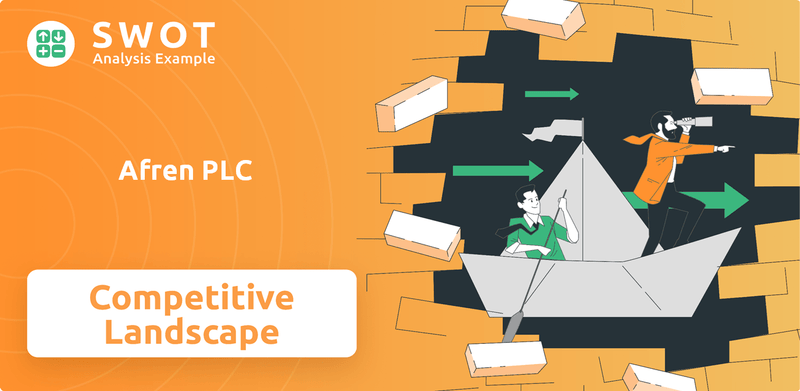
This article dives deep into the Afren PLC competitive landscape, dissecting its journey from ambitious startup to its eventual downfall. We'll explore the Afren PLC market analysis, identify its Afren PLC competitors, and examine the factors that shaped its trajectory. Analyzing the Afren PLC oil and gas operations and Afren PLC financial performance provides key insights into the challenges and opportunities within the sector, offering valuable lessons for anyone navigating the complexities of the energy market. This Afren PLC industry analysis will help you understand the company's strategic partnerships, exploration activities, and its geographic presence.
Where Does Afren PLC’ Stand in the Current Market?
Afren PLC, during its operational phase, aimed to be a leading independent oil and gas exploration and production company. Its primary focus was on Africa, particularly West Africa and Nigeria. The company's strategy revolved around establishing itself as a premier pure-play E&P independent in Africa through partnerships and strategic acquisitions.
The company built a diverse portfolio across multiple African countries, including Nigeria, Côte d'Ivoire, Ghana, and others. Nigeria was central to Afren's production, with over 70% of its reserves and production originating from the country. Afren's market analysis shows its ambition to produce up to 65,000 barrels of oil equivalent per day by the end of 2010.
In 2010, Afren's net income increased by 373% to $45.873 million. The company's return on capital employed (ROCE) rose by 122% to 5.37%. By Q3 2014, net income increased by 30% to $167.1 million from $128.6 million in Q3 2013.
In 2012, Afren was producing over 50,000 barrels of oil equivalent per day. The company aimed for significant production increases to boost its market share. Afren's geographic presence was key to its operations, as highlighted in Target Market of Afren PLC.
Despite periods of strong financial performance, Afren faced significant challenges. The company's financial health deteriorated, leading to its administration in 2015. This was due to a substantial write-down of assets, including over $1.0 billion in Kurdistan oil reserves, and a significant drop in its share price.
- Afren's competitive landscape was significantly impacted by its financial difficulties.
- The company's market share was affected by operational and financial instability.
- Financial performance was highly sensitive to oil price fluctuations.
- Strategic partnerships and collaborations were crucial for its exploration and production activities.
Afren PLC SWOT Analysis
- Complete SWOT Breakdown
- Fully Customizable
- Editable in Excel & Word
- Professional Formatting
- Investor-Ready Format
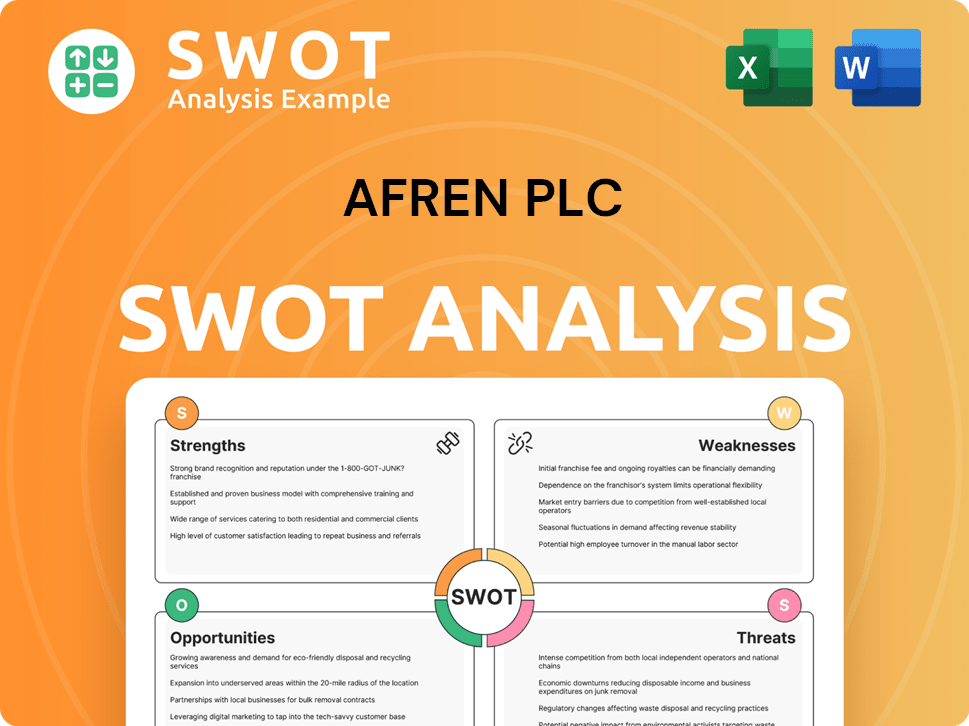
Who Are the Main Competitors Challenging Afren PLC?
In the independent oil and gas exploration and production sector, particularly with a focus on West Africa, understanding the Afren PLC competitive landscape is crucial. The company faced competition from both international majors and other independent players. Analyzing the Afren PLC market analysis reveals a sector where strategic positioning and financial strength are key.
The Afren PLC oil and gas operations were situated in a market traditionally dominated by international oil companies (IOCs). However, independent companies like Afren also played a significant role. The competitive dynamics involved securing exploration licenses, farm-in agreements, and development rights, making strategic alliances and navigating complex regulatory landscapes essential for success.
The African oil and gas sector is traditionally dominated by international majors, although independents have increasingly claimed larger stakes. These major international oil companies (IOCs) often possess vast financial resources, extensive global networks, and advanced technological capabilities, allowing them to undertake large-scale, capital-intensive projects. Their strengths lie in their ability to absorb significant risks, leverage economies of scale, and maintain diversified portfolios across multiple regions.
Major international oil companies (IOCs) like Shell, ExxonMobil, and TotalEnergies were key competitors. These companies had significant financial resources, global networks, and technological capabilities.
Other independent E&P companies operating in West Africa also posed direct competition to Afren. These companies, similar to Afren, focused on specific regions or niche opportunities.
The ability to form strategic alliances and navigate complex regulatory and political landscapes is crucial for success. Afren itself engaged in strategic partnerships with indigenous Nigerian companies.
Competitive 'battles' or market share shifts in this industry often revolve around securing exploration licenses, farm-in agreements, and development rights for lucrative oil and gas blocks.
The withdrawal of Seplat Petroleum Development Co Plc from talks to acquire Afren in 2015 highlights the challenges and risks associated with such transactions, especially when a company is facing significant debt.
The Afren PLC financial performance was significantly impacted by oil price fluctuations. The company's ability to manage debt and secure funding was crucial.
The Afren PLC competitors included both large international oil companies and other independent exploration and production (E&P) firms. The competitive landscape was dynamic, with companies vying for exploration licenses and development rights. Strategic partnerships and navigating regulatory environments were critical for success. The Afren PLC industry analysis reveals that the sector is characterized by high capital requirements and significant risk.
Several factors determined the competitive positioning of companies in the oil and gas sector in West Africa. These included financial strength, technological capabilities, and the ability to form strategic partnerships.
- Financial Resources: The ability to fund exploration, development, and production activities.
- Technological Expertise: Access to advanced drilling, extraction, and processing technologies.
- Strategic Partnerships: Collaborations with local partners and governments.
- Risk Management: Ability to manage geopolitical, operational, and financial risks.
- Market Access: Secure access to markets for oil and gas products.
For further insights into the strategic decisions and market dynamics affecting Afren, consider exploring the Growth Strategy of Afren PLC.
Afren PLC PESTLE Analysis
- Covers All 6 PESTLE Categories
- No Research Needed – Save Hours of Work
- Built by Experts, Trusted by Consultants
- Instant Download, Ready to Use
- 100% Editable, Fully Customizable
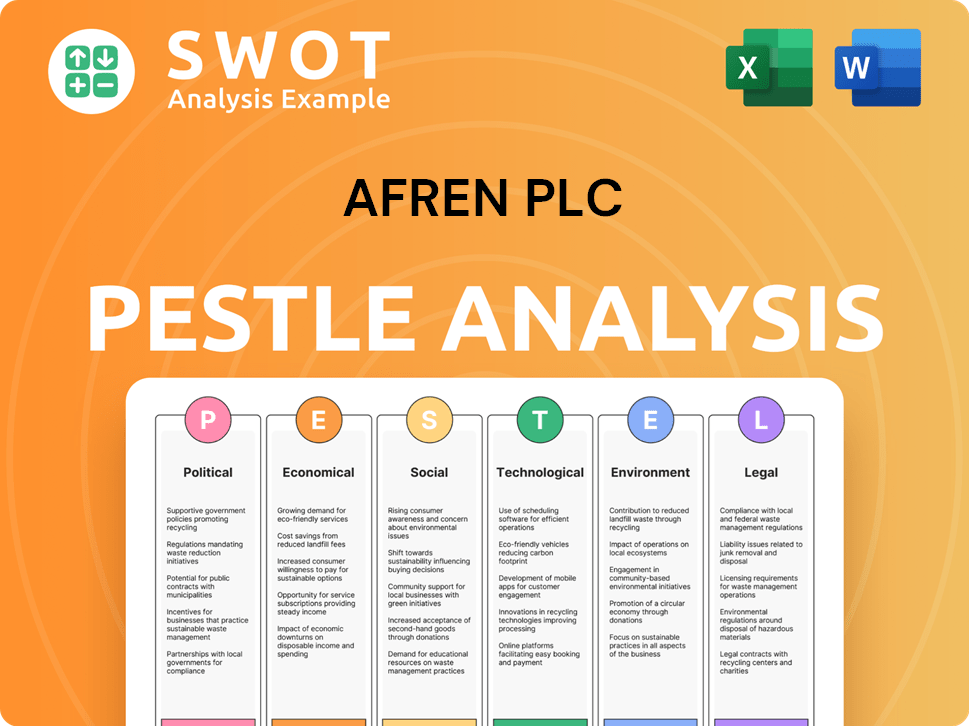
What Gives Afren PLC a Competitive Edge Over Its Rivals?
The competitive landscape of Afren PLC was shaped by its strategic positioning within the African oil and gas sector. Afren focused on an 'Africa-centric' approach, prioritizing partnerships with local entities. This strategy aimed to build strong relationships and navigate the complexities of operating in the region. A deep dive into Marketing Strategy of Afren PLC reveals the company's approach to market dynamics.
Afren's operational model emphasized fast-tracking the development of proven, undeveloped fields, particularly in Nigeria. The Okoro Setu Project, completed in record time, showcased their efficiency. This success positioned Afren as a preferred partner for developing 'fallow' oil fields in the Gulf of Guinea and Nigeria. Their ability to secure reserves at attractive costs was a key advantage.
The company's experienced board, with extensive African experience, provided a significant advantage in understanding the local landscape and regulatory environment. This expertise facilitated operational efficiency and informed strategic decisions. However, external factors and internal issues eventually challenged the sustainability of these advantages.
Afren's focus on partnerships with indigenous companies, host governments, and local suppliers was a key differentiator. This approach helped build strong relationships, crucial in a region where local participation is important. This strategy also helped bridge technical and financial gaps.
Afren demonstrated an ability to develop assets quickly and at a lower cost than its peers. The Okoro Setu Project, completed in two years, showcased this efficiency. This operational prowess made them a partner of choice for undeveloped fields.
The company benefited from an experienced board with extensive African experience and financial expertise. This deep understanding of the local landscape and regulatory environment provided a significant operational advantage. This facilitated informed decision-making.
Afren aimed to secure substantial reserves potential at low unit costs. This focus on economically attractive terms was a key ability in a competitive environment. This strategic approach supported its growth.
The sustainability of Afren's competitive advantages was challenged by several factors. The slump in oil prices and internal issues, such as unauthorized bonus payments, severely impacted the company. These factors led to financial instability and ultimately administration.
- Oil price volatility significantly affected financial performance.
- Internal governance issues undermined operational and strategic strengths.
- External market conditions and internal problems combined to create challenges.
- The company's downfall highlights the importance of financial stability and governance.
Afren PLC Business Model Canvas
- Complete 9-Block Business Model Canvas
- Effortlessly Communicate Your Business Strategy
- Investor-Ready BMC Format
- 100% Editable and Customizable
- Clear and Structured Layout
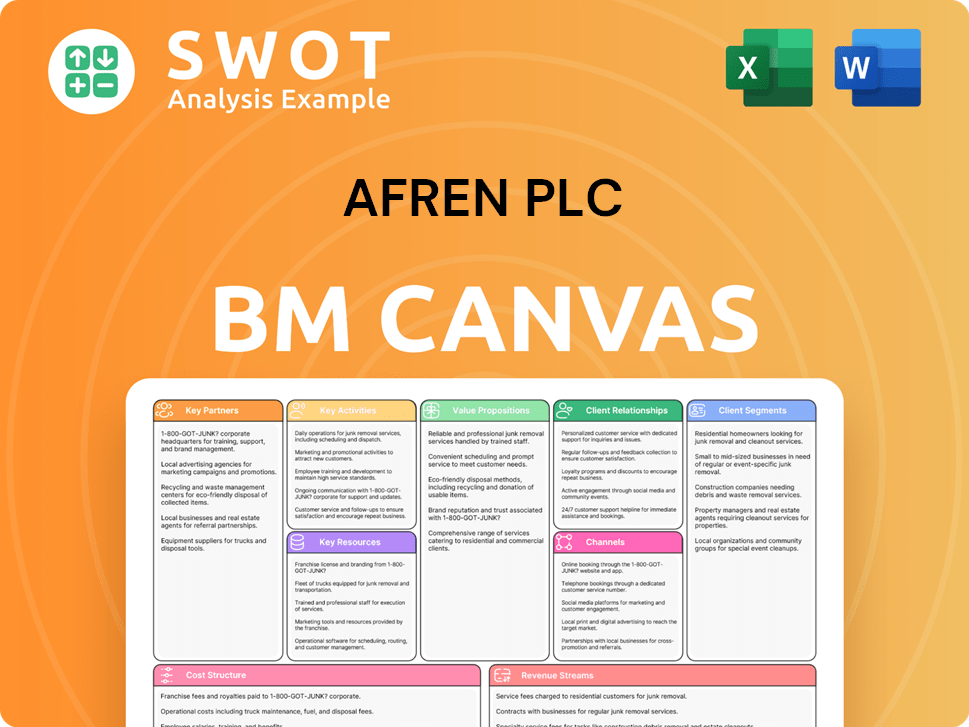
What Industry Trends Are Reshaping Afren PLC’s Competitive Landscape?
The Afren PLC competitive landscape, had it remained operational, would have been significantly shaped by industry trends, challenges, and opportunities prevalent in the oil and gas sector during 2024-2025. The company's strategic positioning, focusing on exploration and production in West Africa, would have faced the pressures of fluctuating oil prices, geopolitical instability, and the increasing need for sustainable practices. A thorough Afren PLC market analysis reveals how these factors influence the competitive dynamics and the potential for growth or decline.
The Afren PLC oil and gas operations would have been subject to the same market forces as its Afren PLC competitors, including independent oil companies and larger integrated firms. Understanding the Afren PLC financial performance and its ability to navigate these challenges would have been crucial. The Afren PLC industry analysis is essential for assessing the company's strategic choices and its prospects for long-term viability.
The oil and gas sector is currently undergoing a digital transformation, with widespread adoption of AI, ML, and IoT. The global AI in oil and gas market is projected to reach USD 25.24 billion by 2034, growing at a CAGR of 14.2% from 2024 to 2034. Sustainability and efficiency are driving the industry towards cleaner energy solutions and reduced carbon footprints.
Volatile oil prices, geopolitical tensions, and macroeconomic weaknesses pose significant challenges. The 2015 slump in oil prices was a major factor in Afren's downfall, illustrating the impact of commodity price fluctuations. New market entrants and changing business models, driven by technological innovation and the energy transition, also threaten traditional players.
Opportunities for growth exist in emerging markets, product innovations, and strategic partnerships. Regulatory changes, particularly in West Africa, continue to emphasize local content and indigenous participation, which was a core part of Afren's original strategy. Companies that can leverage digital transformation and adapt to the evolving energy landscape are better positioned for resilience.
Companies must prioritize high-return investments and maintain production efficiency to ensure robust financial performance. Afren's initial strategy of indigenous partnerships and focus on undeveloped fields in the Gulf of Guinea was aligned with some of these opportunities, but financial vulnerabilities and internal issues proved insurmountable.
Had Afren PLC continued operations, it would have needed to navigate a complex landscape. The company's focus on West Africa presented both opportunities and risks related to regulatory changes and local partnerships.
- The company's exploration and production activities would have been influenced by volatile oil prices, as demonstrated by the 2015 downturn.
- The adoption of digital technologies and the push for sustainability would have required strategic investments.
- Strategic partnerships and an emphasis on local content could have offered avenues for growth, aligning with the original business model.
- For more detailed insights, see our article on the Afren PLC competitive landscape.
Afren PLC Porter's Five Forces Analysis
- Covers All 5 Competitive Forces in Detail
- Structured for Consultants, Students, and Founders
- 100% Editable in Microsoft Word & Excel
- Instant Digital Download – Use Immediately
- Compatible with Mac & PC – Fully Unlocked
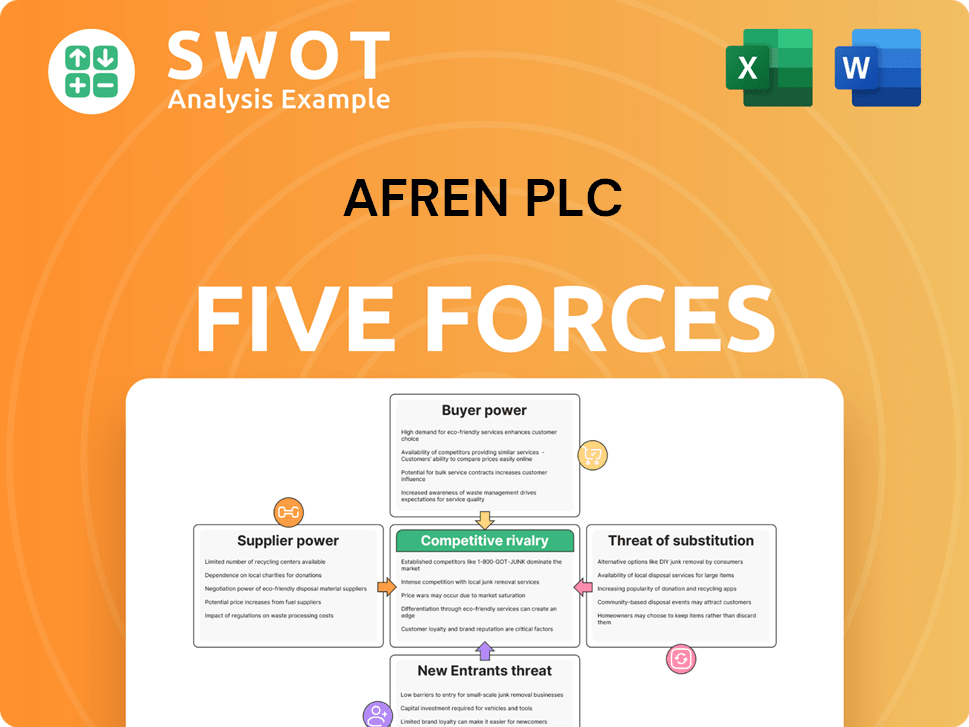
Related Blogs
- What are Mission Vision & Core Values of Afren PLC Company?
- What is Growth Strategy and Future Prospects of Afren PLC Company?
- How Does Afren PLC Company Work?
- What is Sales and Marketing Strategy of Afren PLC Company?
- What is Brief History of Afren PLC Company?
- Who Owns Afren PLC Company?
- What is Customer Demographics and Target Market of Afren PLC Company?
Disclaimer
All information, articles, and product details provided on this website are for general informational and educational purposes only. We do not claim any ownership over, nor do we intend to infringe upon, any trademarks, copyrights, logos, brand names, or other intellectual property mentioned or depicted on this site. Such intellectual property remains the property of its respective owners, and any references here are made solely for identification or informational purposes, without implying any affiliation, endorsement, or partnership.
We make no representations or warranties, express or implied, regarding the accuracy, completeness, or suitability of any content or products presented. Nothing on this website should be construed as legal, tax, investment, financial, medical, or other professional advice. In addition, no part of this site—including articles or product references—constitutes a solicitation, recommendation, endorsement, advertisement, or offer to buy or sell any securities, franchises, or other financial instruments, particularly in jurisdictions where such activity would be unlawful.
All content is of a general nature and may not address the specific circumstances of any individual or entity. It is not a substitute for professional advice or services. Any actions you take based on the information provided here are strictly at your own risk. You accept full responsibility for any decisions or outcomes arising from your use of this website and agree to release us from any liability in connection with your use of, or reliance upon, the content or products found herein.